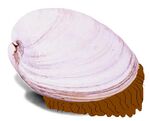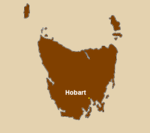Bearded clam
Scientific name: Vaginix lusoria
Though now extinct, this marvellous creature once populated the land we now know as Britain, where its beard was prized for making beer. The ruthless hunting of the bearded clam by the Angles, Saxons, Jutes and Cockernees eventually brought about the extinction of the species in its home territory, forcing the use of hops instead.
Geographical distribution[edit]
Although extinct in the waters off the British Isles, isolated populations still exist elsewhere.
Australia[edit]
Bearded clams arrived in Australia with the First Fleet in 1788. They are greatly honoured in Australian culture, particularly in the facial hair of the male population. They are particularly prevalent in Tasmania.
Unbearded or "brazilian" clams are now aquacultured on Cocos Island. Having no hair they are predominantly pink and stay fresher longer. Original flavour and odour is retained. They require a good tongue bath regularly to keep them happy. Unlike the original bearded variety from the 70s.
Europe[edit]
Bearded clams thrive in continental Europe. Germany in particular has set up numerous wildlife refuges where bearded clams can roam entirely free. Famed biologist Antoine de Caunes is widely respected for his work in studying these habitats. His extensive archive of filmed material taken in habitats across Europe has been instrumental in raising awareness of these reclusive creatures in areas where they are rarely seen. In Britain, for example, his research was frequently shown on national TV station Channel 4. The initial impact seemed unfavourable: a senior church leader in particular expressed his outrage, but he was not reflecting public opinion. Many viewers ended up bashing the Bishop after watching the footage for themselves. In the longer term it has certainly led to an increased interest in bearded clams and their activities.
Brazil[edit]

Bearded clams were introduced to South America by the Conquistadors in the sixteenth century. Isolated from their european gene pool, the Brazilian bearded clam is almost hairless.
Life cycle[edit]
Little is known about the life cycle and breeding habits of this shy and retiring creature. Some species of bearded clam enjoy an almost symbiotic relationship with the even more rarely encountered White-eared Elephant. Others prefer the company of their own species.
Born wet or underwater, they do not yet have a beard. As they approach the end of their life cycle they have been known to dry out and be unable to close and usually only have a few whiskers left. Although some bearded clams are found with amazingly long beards at the time of death.
Without direct visual identification, they can usually be mistaken for the chocolate starfish by some divers.

